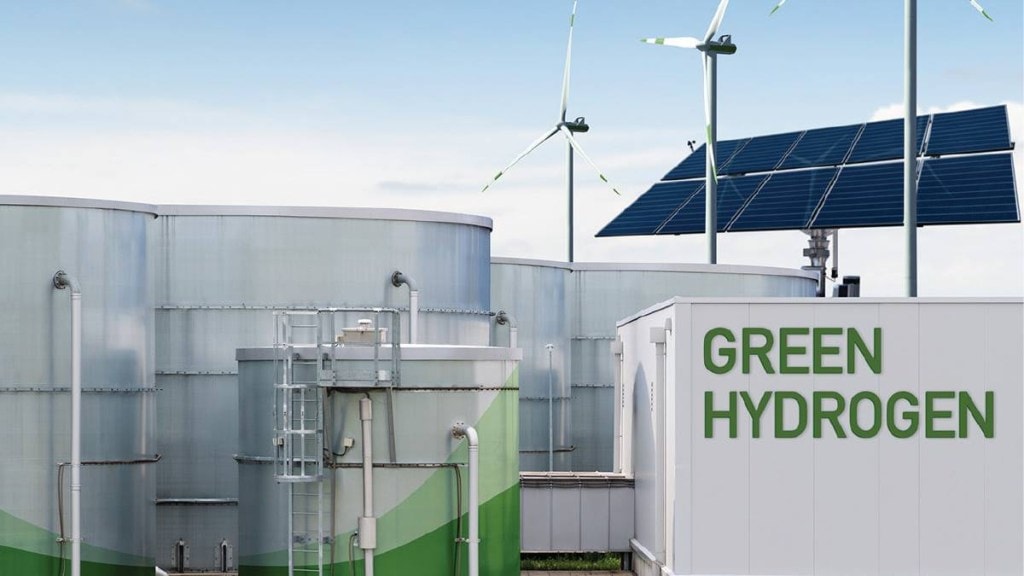– By HDFC Asset Management Company Limited
Decarbonisation is necessary for India to reach its Net Zero goal by 2070. Green Hydrogen is emerging as a popular choice for enabling greener operations in industries such as iron ore and steel, fertilizers, refining, methanol, and maritime shipping. Energy Independence could be a key outcome from Green Hydrogen adoption – with Green Hydrogen substituting fossil fuel imports of Rs 1 lakh crore by 2030. There have been significant investments to increase renewable energy capacity and incentivisation for the Green Hydrogen ecosystem.
What is Green Hydrogen?
Green Hydrogen is produced by the process of electrolysis, where water is split into hydrogen and oxygen using electricity generated from renewable sources like solar, wind, or hydropower. This process results in a clean and emission-free fuel that has immense potential to replace fossil fuels and reduce carbon emissions. Another method of producing Green Hydrogen is from biomass, which involves the gasification of biomass to produce hydrogen.
Green Hydrogen – Key Uses
Global Hydrogen demand is currently driven by its use in refining and ammonia (fertilisers). A large part of likely future demand is driven by its use as a heating material in various industries (Steel, paper, cement, aluminium, food) and as feedstock in various products such as Metallurgy, Steel, Food, Glass. On combustion, hydrogen turns into water, thereby being non-polluting.
India’s Green Hydrogen Ambition – Brief Background
To establish dominance in this new energy commodity, India has been taking steps to promote use of Hydrogen. In 2021, the Prime Minister signalled the launch of the National Green Hydrogen Mission “to make India a Global Hub for Green Hydrogen Production and Export in the Amrit Kaal” and “to make a new progress in the field of energy self- reliance.” Last year, the Cabinet approved the National Green Hydrogen Mission with an outlay of Rs 19,744 crore.
National Green Hydrogen Mission (NGHM) – Key Components
NGHM comprises the Strategic Interventions for Green Hydrogen Transition program (SIGHT) with an outlay of Rs 17,490 crores, Rs 1,466 crores for pilot projects, Rs 400 crores for R&D, and Rs 388 crores towards other Mission components. The SIGHT Programme consists of 2 financial incentive mechanisms – targeting domestic manufacturing of electrolysers and production of Green Hydrogen (update on these in the ‘Recent developments’ below).
Recent developments under the NGHM
- The agency which conducted the ‘Request for Selection’ (RfS) process for the 2 financial incentive mechanisms under SIGHT, got bids for higher capacity than what was invited for. While 21 companies bid for manufacturing of electrolysers, 13 companies bid for setting up facilities for the production of Green Hydrogen. While this process will continue to take its own course, it validates the availability of manufacturing and production confidence amongst suppliers. Large, quality names have applied under both the categories.
- Another key highlight in the past year was the setting up of Green Hydrogen Standard for India, that outlines the emission thresholds that must be met in order for hydrogen to be classified as ‘Green’, i.e., from renewable sources. Under these standards, Hydrogen produced with a well-to-gate emission (i.e., including all processes) of not more than 2 kg CO2 equivalent / kg H2 is considered as Green Hydrogen. A key benefit of this standard is that it brings a lot of clarity to the Green Hydrogen community in India and simplifies global funding of these projects. India is now one of the first few countries in the world to announce a definition of Green Hydrogen.
- In October 2023, a report on the R&D roadmap for the Mission was unveiled, a comprehensive document that outlined R&D priorities and the overall framework for the sector in India. Various other measures such as simplifying norms and business practices are being carried out.
Recent bids under the incentive mechanisms are likely to propel the concept of Green Hydrogen in India to the next level, and could see the evolution of an ecosystem. Steps towards development of Green Hydrogen have the potential to reduce India’s reliance on hydrocarbon imports and result in savings on the current account. In fact, the union government has also worked on proposals that could see export of this commodity over time. As the world increasingly focusses on Net Zero emissions, Hydrogen usage is likely to improve. Being early to scale could have immense benefits for the Indian economy. Challenges remain in terms of scaling the usage and technology behind Hydrogen.
(The article is authored by HDFC Asset Management Company Limited.)
(Disclaimer: Views expressed are personal and do not reflect the official position or policy of Financial Express Online. Reproducing this content without permission is prohibited.)

